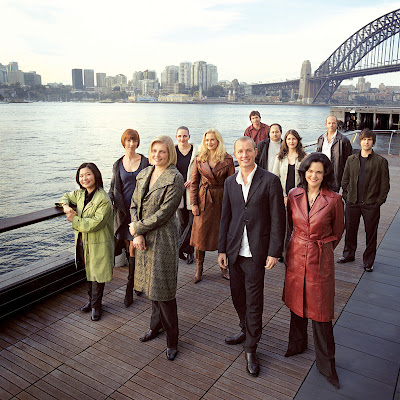
Australian Chamber Orchestra, photo by Stephen Oxenbury |
As part of its
current American tour, the
Australian Chamber Orchestra stopped by the Clarice Smith Performing Arts Center Friday night, on the way to Carnegie Hall.
Richard Tognetti, the group's lead violinist and artistic director, led the sort of energetic, polished, unified performance that dedicated listeners have come to expect. Traversing music in a range of styles, the ACO exploited the full range of dynamic contrasts and textures. No element was out of place, and yet the level of precision did not lead to a feeling of coldness or emotional distance. The group gives the air of joyful collegiality, warmly applauding their own soloists, for example, and sharing smiles and knowing glances, although more often than not, a serious devotion to music making reigns.
Two Baroque selections were idiomatic and dramatically etched, especially the F major concerto grosso by Corelli (op. 6, no. 2). Tognetti's cadenzas wove together the sectionalized first movement, joining pulse-racing Vivace with the searing suspensions of the Adagio. All players contributed equally well in the contrapuntal sections, as in the opening of the second movement and the interplay of the fourth. The Vivaldi selection, the concerto for four violins (B minor, op. 3, no. 10), is far more familiar but was less even, not least because Tognetti's solo contribution stood out so much from those of his three colleagues. One had the sense that Tognetti was trying to drive the tempo forward, but it flagged slightly when he was not playing. The juxtaposition of the two composers forces a comparison of their music, which leaves one wondering how on earth Vivaldi can be so much more popular today than Corelli.
The first half concluded with a Viennese classical concerto, Haydn's C major cello concerto (Hob. VIIb), for which the ACO was joined by
Pieter Wispelwey. The Dutch cellist, at home on period and modern instruments, set the tone for the piece with a full-throated sound that lent a certain rustic, jolly quality. Wispelwey's extended cadenzas, similar to what he played on his recording of the Haydn cello concerti, were eclectic and fun, if not particularly idiomatic to the period. Replete with challenging pizzicati, strummed chords, and multiple stops, the cadenzas played against the earthy simplicity established in the first movement. An expansive, stately slow movement and a white-knuckled "very fast"
Allegro molto, showing off the facility and accuracy of the entire group, rounded out a fine rendition of this popular concerto, rediscovered only in the mid-20th century. One hoped for a movement from a Bach suite -- on the basis of Jens's
review of Wispelwey's recording -- as an encore, as he had played in previous appearances on this tour. No one was disappointed when, quietly observing the
passing of Mstislav Rostropovich earlier in the day, Wispelwey offered instead a movement from Benjamin Britten's suite for unaccompanied cello (the passacaglia from the third suite, I think), composed for and dedicated to Rostropovich. As the final notes trailed off into the air,
sotto voce and
morendosi, it made me imagine Slava circling the earth to listen to the many tributes offered in his memory that night.
The best playing of the evening was on Tchaikovsky's
Souvenir de Florence, op. 70, which constituted the second half. A meaty and extended work conceived for string sextet and arranged here for string ensemble, it is based on music sketched out during the composer's visit to Florence. The first-movement waltz featured beautiful duets between Tognetti and the whiskey-voiced viola, leading up to a wild
accelerando to an exciting conclusion. The second movement's delicate melody, played with admirable purity by Tognetti, was accompanied by guitar-like pizzicato chords. The hushed, quick middle section was shaped into wind-like sweeps of sound. The Russian-flavored third and fourth movements added to the impression that the strings of the Australian Chamber Orchestra were a larger group than they were, with the dynamic scope of a full orchestra but a finer sense of cohesion. Two encores capped off the evening, with the sugary frosting of Tognetti's own string ensemble arrangement of Debussy's prelude for piano,
La fille aux cheveux de lin (The girl with the flaxen hair) washed down with a more nutritious arrangement of the Allegro molto movement from William Walton's second string quartet.
The Australian Chamber Orchestra plays the same program this evening at Zankel Hall in Manhattan (April 29, 7:30 pm).

In case you are interested, there is an amazing video of the Eroica symphony played by the ACO in February of this year, available in full for free:
ReplyDeletehttp://www.aco.com.au/Index.aspx?EID=295